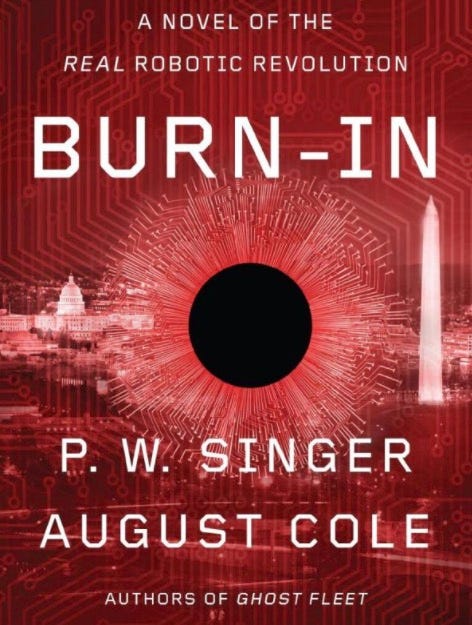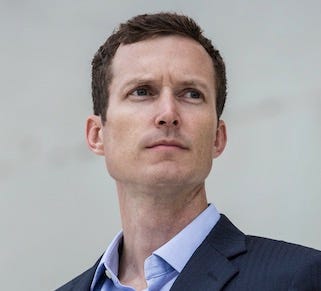'What if a murderer never had to leave their own house' - AI and climate change
Futurist author August Cole tells Callaway Climate Insights what's in store for climate in an AI world

(David Callaway is founder and Editor-in-Chief of Callaway Climate Insights. He is the former president of the World Editors Forum, Editor-in-Chief of USA Today and MarketWatch, and CEO of TheStreet Inc.)
SAN FRANCISCO (Callaway Climate Insights) — I recently sat down with August Cole, a former colleague of mine at MarketWatch and currently a best-selling author of fiction about the intersection of AI and global conflict. His latest book, Burn-In, co-authored with P.W. Singer, is a thriller about the role AI plays in society only about 15 years from now. So we asked him about climate change then.
Question: Burn-In is the story of an FBI agent and her partner on a national mission, but the partner is an AI-controlled robot — TAMS. It’s a real thriller, but you both had to imagine what AI, and indeed the world, will look like 15 years from now. What were your climate assumptions and how did you get to them?
Answer: There’s a quote attributed to William Gibson, sci-fi legend who coined the term cyberpunk, that the future is already here, it’s just not evenly distributed. To riff on that, the climate of the future is already here, but it’s effects aren’t equally distributed. The weather in Burn-In is volatile, with big swings for example, that compound the other technological-driven disasters that take place in the book. It’s hotter, wetter, and unpredictable. When we were building out the world of the 2030s in Washington, D.C., we knew we had to look at some of the climate projections from international bodies like the UN, but also to understand what it would be like, in a sensory and emotional way, to live in such a world. What we wanted to do was also show how the systemic vulnerabilities that hackers could exploit in Internet-connected infrastructure could be compounded by naturally occurring extreme-weather events, such as flooding in downtown Washington. Since there is a call-to-action aspect to the novel, we wanted to demonstrate as well that the current precautions like flood barriers don’t really reflect the looming danger.
Q: A lot of climate investing strategies are either de-leveraging fossil fuels or betting on renewables or both, a transition play. Is there also an AI play that investors might be missing?
A: If climate investing strategies are a bet on systemic changes in investment, policy, and behavior all shifting at a certain point to be in phase for a before-after generational shift, AI investment and adoption is more scattershot — and perhaps harder to call. It is certain that literally every single company and organization in the next decade will have to have an AI strategy that reflects a similar before-after aspect of this technology’s potential. What is difficult, however, are two things: 1. It is difficult to define exactly what AI is, and therefore coalesce around how to invest in and even implement it. (I see it as a family of software, and hardware, capabilities that allow degrees of cognition by computing systems.) 2. Since literally every facet of society is going to be impacted, companies as well as governments and even individuals have to account for the way that it will be so pervasive — not just how they internally plan to use it. Commerce will move at machine speed, particularly robotics. Culture will be more both highly personalized and yet algorithmically shiftable at a global scale not previously experienced. Politics will be more extreme as technological and economic inequality around the world grow. Is that world better equipped to stop or cope with climate change? It seems that AI, such as predictive weather or energy models, offers some utopian-type solutions. But these ancillary trends might also make it harder to fulfill that promise, no matter how much is invested.
Q: In a world of automated, electric vehicles and energy efficient buildings controlled by phone or an app, what will the archvillains of your novels and real life in the future be focused on? Grid manipulation? Control of water resources? Any others?
A: What if a murderer never had to leave their own house to commit a violent crime? Could they hack a neighbor’s smart home? We really freaked ourselves out when we showed how this could happen in Burn-In — it made me want to be even more of a luddite. Yet AI and the Internet of Things are coming, and will offer real benefits, particularly in developing societal resilience against climate change if we can avoid the pitfalls that I mentioned earlier. Using machine-learning to reduce energy use, altering traffic and commuting patterns, or refining something like air-travel flight plans can add up to big benefits in carbon-output reduction when done on a global scale. How we move forward with such advances is the key to whether a villain or terrorist or government can exploit those supposed improvements. An example is old infrastructure like water management systems that will be hooked up to the web and may not be adequately secured. These systems are already being targeted in water-critical countries like Israel; I’d expect them to be targeted even more in the future because it’s a shared point of weakness. For water itself, I’d suggest reading The Water Knife by Paolo Bacigalupi, a phenomenal sci-fi writer whose story of the future water wars in the Southwest and California is a must-read for anybody thinking seriously about climate futures where we really blow it. Less dystopian, Eliot Peper’s new “cli-fi” novel Veil explores the great-game type politics around innovators developing terra-forming type climate technologies here on Earth as we fight, and sometimes even collaborate, to survive on a hotter planet.
Q: In your book, one of the primary lessons is that everything online is accessible, not only to people but to machines. Will this type of data access play into the climate debate in terms of carbon footprint disclosures?
A: We talk today about having our five senses — essential to the kind of visceral writing I like to do — but a sixth could be added: data. It is vital to how we experience and know the world around us, and is increasingly determinative to so many aspects of our lives, from how we love or work or reflect. When you start to see augmented reality take off access to data will be transformed because in a sense it will finally be visible. Imagine waking up and having the carbon footprint of every aspect of your daily routine, if you really wanted to know, presented to you in terms of ethereal wisps of color or perhaps numerical values. Maybe an optimal set of choices is in your field of view at all times. What this is predicated on is not just having the data, but finding a set of norms and values that allows us access to the data required to build those models. With AI technologies like neural networks and digital twins you could literally create different possibilities for yourself to understand what kind of carbon-footprint day you were going to have. Essentially the stories we tell ourselves about our present and future lives will be greatly shaped by real foreknowledge about our roads not taken. Not all societies will decide choice is desirable, however, and I fear that we have a preview of that future in China’s intrusive and repressive social credit system. I don’t know who said it but the phrase one person’s utopia is another’s dystopia is a really important one to remember. And this construct of using data to “do the right thing” presupposes a level of choice that not all societies will be able to afford, either. Offering access to such data and tools for those nations potentially most vulnerable and least able to combat the effects of climate change almost has a sort of moral imperative. But we are just at the beginning of politicking over data rights and access, and perhaps this aspirational use of it can help break some of the current paradigms so we can reclaim the information that we ourselves create.
Q: What's your next book about?
A: I continue to explore the future of conflict, in its many forms, with a particular focus on the role data is going to play in shaping how we experience and shape the perception of what we today call war. As AI computing capability becomes wearable and shareable there is going to be a renewed contest over narratives, particularly in strategically vital regions like the Arctic. As well, Pete and I have some great ideas that could manifest in Agent Keegan and her robot partner TAMS taking on an even bigger case ...

(August Cole is the co-author of Burn-In: A Novel of the Real Robotic Revolution (2020 Houghton Mifflin Harcourt) and Ghost Fleet: A Novel of the Next World War (2015 HMH). A non-resident fellow at the Brent Krulak Center for Innovation and Creativity at Marine Corps University and a non-resident senior fellow at the Atlantic Council’s Scowcroft Center for Strategy and Security, he regularly speaks to and writes future narratives for government and private-sector organizations. He’s on Twitter at @august_cole.)

